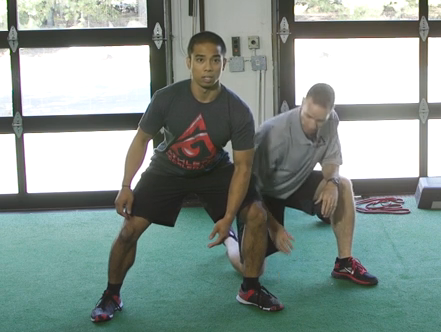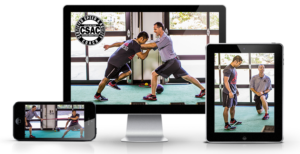
How Survival Instincts Drive Speed Development
Today’s guest post comes from Lee Taft, the creator of the Certified Speed and Agility Coach (CSAC) course. I’m a huge fan of this certification, and it’s on sale for $200 off through Sunday at midnight. Enjoy! -EC
As a kid, I was a big fan of “The Flintstones.” I loved how Fred and Barney could run so fast. I can remember when they were chased by a Sabretooth Tiger; it was amazing how they could escape so quickly. Hmm, maybe there is something to that…
Fast forward to 2017, I still love speed. But now, I actually study it. I continually ask myself the question; “Why were humans given the ability to have speed and quickness?” This question has taken me down a road not many speed coaches travel. Many of these coaches like the traditional route of current methods of training. That’s cool, and in most cases, proves to be quite successful. But…
What if coaches would investigate more down the road of our human history? What if they allowed themselves to be vulnerable to the ways of how we escaped or attacked for survival? How would they think differently about speed?
What if we asked the question, “Why were we given the ability to have speed and quickness?” What can we learn when we venture down that path?
Here are a few of my thoughts:
1. Survival drives us through channels not so easily understood from a Central Nervous System (CNS) standpoint. We have to bow down to the subconscious effort that makes us move quickly on instinct or reflex. This is harder to understand, so we try to ignore it as a viable option for speed training.
2. Playing competitive sports actually taps into our CNS – or should I go deeper and say our “sympathetic nervous system?” This is where our heightened awareness of our surroundings kicks in. If I am caught in a rundown in baseball – or going to be tackled in football, or being chased during soccer i- it takes us to a level of effort we don’t commonly experience in our daily lives.
3. Our body kicks into what we call fight or flight: the survival mode. This occurs all the time during sports competition. It drives us to make incredible speedy plays. It forces us to react in such a way that our feet move quicker than our conscious mind can drive them. This is where I want to concentrate on for the rest of this article. I want to share with you strategies to make you faster!
Repositioning
Repositioning is a term I use to relate to how an athlete moves his or her feet quickly into a more effective angle to either accelerate or decelerate the body. Terms I have used to describe repositioning are:
Plyo Step: The plyo step is an action that occurs when one foot is repositioned behind, to the side, or at any angle behind the body. This act quickly drives the body in a new direction of travel.
Hip Turn: This is basically the same as the plyo step except the athlete turns and accelerate back away from the direction they were facing. Repositioning occurs to find an angle to push the body in that direction.
Directional Step: Think base-stealing. The athlete will face sideways but turn and run. The front foot opens to be in a greater supportive position to push down and back during acceleration steps.
The goal is to get into acceleration posture as quickly as possible to make a play when one of these repositioning steps occur.
A great drill to work on repositioning is what I call “Ball Drops.”
a. Simply have a partner or coach stand 10-15 feet away from the athlete with a tennis ball held out at shoulder height.
b. The athlete is in an athletic parallel stance facing the coach, turned sideways, or back facing- depending on the drill.
c. The coach will drop the ball and the athlete must accelerate to catch the ball before the 2nd bounce. I encourage the coach to use the command “Go” at the exact time of the drop to help when vision is not an option.
The action you will see 99.9% of the time is a repositioning or a hip turn or plyo step (the directional step is the act of preparing the front leg for push off; it angles in the direction of travel). Perform this drill facing forwards for four reps, sideways for four reps, and backwards for four reps (2 to eaach side for the side-facing and back-facing). Perform this drill 2-3x per week to tap into the “fight or flight” response.
Reactive Shuffle or Crossover
In this drill, the focus is on reacting to either a partner (like a mirror drill) or the coaches signal to go right or left.
a. The athlete gets in a great defensive stance and prepares to explode to her right or left.
b. The coach will quickly point in either direction.
c. The athlete will create quick force into the ground in the opposite direction of travel. Typically, there will be a repositioning step unless the athlete starts in a wide stance where outward pressure is effective in the current stance.
d. As soon as the athlete shuffles one to two times, he will shuffle back.
e. The same drill is repeated, but now using a crossover step.
Perform 3-4 sets of ten seconds of both the shuffle and crossover drill. Allow 40-60s of recovery between bouts.
Shuffle
Partner Mirror
Crossover with Directional Step
Hip Turn to Crossover
The final skill I want to write about might be one of the most important “survival” speed skills an athlete can have. It falls under the “retreating” set of skills where the athlete moves back away from the direction they are initially facing.
The hip turn can allow an athlete to escape or attack. The critical features are:
1. The athlete must “stay in the tunnel.” Do not rise up and down; stay level.
2. By staying level, the immediate repositioning that takes place allows for a great push off angle to move the body in a new direction.
3. The athlete should attempt to create length and cover distance quickly. Short choppy steps are not effective when in “survival mode.” GET MOVING!
4. In the snapshots below, the athlete is performing a hip turn based on the coaches command or signal. The athlete will perform a hip turn and either a shuffle, crossover, or run – and then recover back to the start position as soon as possible!
Perform 3-4 sets of 7-10s of work. If quickness/speed is the goal we want to do it in short bursts of time and not long duration where speed in compromised. Recover for roughly 45 seconds and repeat.
Now, I know it sounds kind of crazy to be talking about survival, cavemen, and “fight or flight” when we are referring to speed, but we have to always look at the genesis of all things. Animals that don’t have reactive speed have other ways to protect themselves. Humans have intelligence and the ability to escape or attack using systems derived out of our CNS to help us use our speed. Our job as coaches is to tap into this ability and use it to help our athletes “naturally” move fast!
Note from EC: As I mentioned earlier, Lee Taft is the creator of the Certified Speed and Agility Coach (CSAC) course. To say that it’s excellent would be an understatement, and we’re actually implementing it as part of our staff training curriculum; all CSP coaches go through the CSAC course. In fact, I think so highly of Lee’s work that it was even filmed at our facility! Through Sunday at midnight, it’s on sale for $200 off. If you’re looking for top notch direction in coaching movement training with your athletes, look no further. You can check it out HERE.











